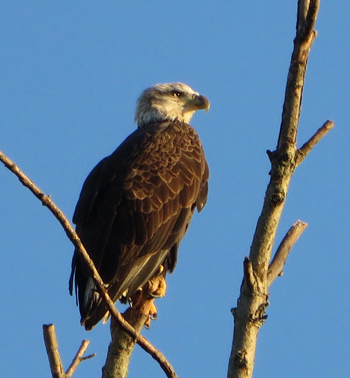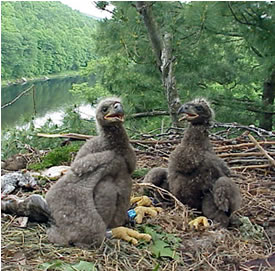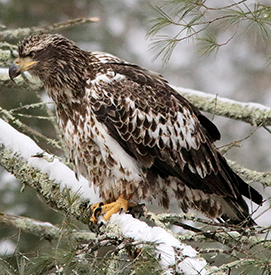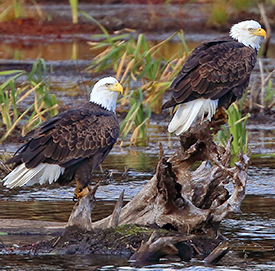Delaware • New Jersey • Pennsylvania
New York • United States of America
 |
Despite objections from Benjamin Franklin, the bald eagle was selected as our national emblem on June 20, 1782, because of its long life, great strength, and majestic looks. At the time, it was estimated that the national bald eagle population was about 100,000 birds.
The first major decline in population occurred during the late 1800s.
Large numbers of the birds were killed indiscriminately prior to federal protection under the Bald Eagle Act of 1940. The heavy use of DDT and other pesticides, which became widespread by the 1940s, also had a significant effect on the bald eagle population because these chemicals inhibited successful reproduction by making the shells of the eagle eggs too thin to hatch.
By the 1960s a single bald eagle sighting along the Delaware River was rare; this is particularly noteworthy since hundreds of bald eagles previously wintered along the river. Bald eagles are predominantly fish eaters, which is why they build their nests and live near water, and why they migrate to open water areas during the winter months.
Bald Eagles Today
One very important reason for the return of the eagle was the federal government's decision in 1972 to ban the manufacturing of DDT in the United States.
Programs by the Delaware River Basin Commission and other agencies and organizations to keep the river and its tributaries clean, the fish abundant, and the habitat undisturbed also have been a big help in the recovery of the bald eagle population throughout the Basin.
Today, bald eagles are still considered threatened in New York, but they are no longer listed as an endangered species at the federal or Basin state level. The number of bald eagles found in the Delaware River Basin has rebounded dramatically.
New York
The 120-mile stretch of the Delaware River from Hancock, N.Y. to the Delaware Water Gap is one of the largest and most important inland bald eagle wintering habitats in the Northeastern United States. The Delaware River is considered an "essential" bald eagle winter habitat by the U.S. Fish and Wildlife Service. Preservation of "essential habitat" is considered necessary for the full recovery and long-term survival of this species.
In New York State, only one pair of bald eagles nested in 1976. Thanks to conservation efforts, in 2019, it was estimated that there are close to 500 nests in the state. The upper Delaware River Watershed provides prime eagle viewing in the winter, and it has become a popular off-season activity. The New York State Dept. of Environmental Conservation works cooperatively with the Delaware Highlands Conservancy and the National Park Service Upper Delaware Scenic and Recreational River to help visitors find and properly observe wintering eagles.
Pennsylvania
The Pennsylvania Game Commission reports over 300 nesting bald eagles were documented in Pennsylvania in 2019, with eagles nesting in nearly all of the state's 67 counties. As a comparison, there were only three known nesting pairs in 1980. The Poconos and upper Delaware River region are home to one of the three largest concentrations of eagle nests in the state. Bald eagles have even nested successfully in Philadelphia and other areas along the tidal Delaware River (south of Trenton, N.J.).
New Jersey
According to the New Jersey Division of Fish and Wildlife, in 2023, there were more than 255 active nest sites that produced 309 fledglings. The numbers of wintering eagles also rose significantly. Most nests are located in the southern part of the state, particularly within about 12.5 miles of the Delaware River and Bay, but all counties reported eagles. To compare, fewer than 10 bald eagles were observed in the state in 1978.
In January 2025, New Jersey announced that it removed bald eagles (and ospreys) from its endangered species list; visit https://dep.nj.gov/newsrel/25_0002/ to learn more.
Delaware
In 2023, Delaware Division of Fish and Wildlife biologists documented 121 nests with 82 active breeding pairs. During the 1980s, there were as few as two to four nesting pairs in the entire state.
Hopefully, ongoing bald eagle restoration programs will result in even greater numbers of this living symbol of America's freedom and spirit returning to a river which witnessed a nation's birth.
- Are bald eagles bald? No, their heads are covered with feathers which turn white as the birds mature. The word "bald" is a derivative of "balde," an old English word meaning white.
- Did Benjamin Franklin really prefer the turkey over the bald eagle as America's national emblem? Yes! Read more.
-
Eagles and other birds have three eyelids. There are two outside eyelids; the bottom is bigger than the top, so they blink up instead of down. The inner eyelid is called a nictitating membrane; it grows in the inner corner of the eye, right next to the tear duct, is transparent, and sweeps across the eye from side to side.
-
Bald eagles hold the record for the biggest bird nest ever built. One nest in Florida was over 20 feet deep, over nine feet wide, and weighed almost three tons!
-
Eagles have special feet with talons, not claws. Why? Talons are designed to carry things. An eagle foot has four muscular toes, powerful enough to hang onto a large fish as it carries it through the air.
 |
 |
 |
| Two eaglets perch on a nest along the upper Delaware River in NYS. Photo by Peter Nye, NYSDEC. |
A juvenile bald eagle perched in the snow. Photo by Martha Tully. |
Two adult bald eagles. Photo by David B. Soete. |
Local Organizations
State Agency Information
- Delaware Dept. of Natural Resources & Environmental Control (DNREC) Video: Delaware's Bald Eagles (link to DNREC YouTube Channel)
- New Jersey Department of Environmental Protection
- New York State Department of Environmental Conservation (NYSDEC)
- Pennsylvania Game Commission
Federal Agency Information
- National Park Service (NPS) - Upper Delaware Scenic and Recreational River
- NPS - Delaware Water Gap National Recreation Area
- U.S. Fish and Wildlife Service: Bald Eagle
- USGS Patuxent Wildlife Research Center
Other
Copyright © Delaware River Basin Commission,
P.O. Box 7360, West Trenton, NJ 08628-0360
Phone (609)883-9500; Fax (609)883-9522
Thanks to NJ for hosting the DRBC website